Why AC won the Electricity Wars
by Jason Crawford · March 9, 2019 · 11 min read
I recently finished the book Empires of Light, by Jill Jonnes, about the “War of the Electric Currents”—AC vs DC—that took place as the electricity industry was getting established in the late 1800s. It is a common story in technology: two competing standards, with ardent proponents of each. But DC was doomed from the start—not for lack of backers, since it was favored by the world-renowned Thomas Edison, but by physics and economics.
Let’s back up. Electricity, as a science and a technology, developed over the course of the late 1700s and 1800s. At first, the only known way to create an electric current was chemically, using batteries (invented in 1799 by Italian physicist Alessandro Volta; batteries are rated in “volts” named after him). Early batteries, though, were relatively weak, producing only a couple of volts; this could power new electrical communications, such as the telegraph, but it wasn’t a practical source of power for light or motors.
Electricity, however, is deeply intertwined with the force of magnetism. Each can induce the other: an electric current creates a magnetic field, and a magnetic field can create an electric current. The latter discovery (by Michael Faraday in 1831) led to the invention of the electric generator, which creates power by spinning a magnet near a coil of wire. A generator can be connected to a source of mechanical power, such as a steam engine, to convert kinetic energy into electrical.
By the late 1800s, electricity had become a mode of power to rival coal and oil. The applications, as with any form of energy, were mechanical power (in the form of the electric motor), heat, and especially light. Lighting was the “killer app” of the early electrical industry—the one application that was so valuable that it would drive the development of the technology and investment in infrastructure.
Early electric lights, however, left much to be desired. The original technology was the arc lamp, in which an electric arc was made to leap through the air between two carbon rods. This produced a very bright white light, harsh and glaring. It was workable for stadiums, theaters, and major commercial streets, but not for homes or offices.
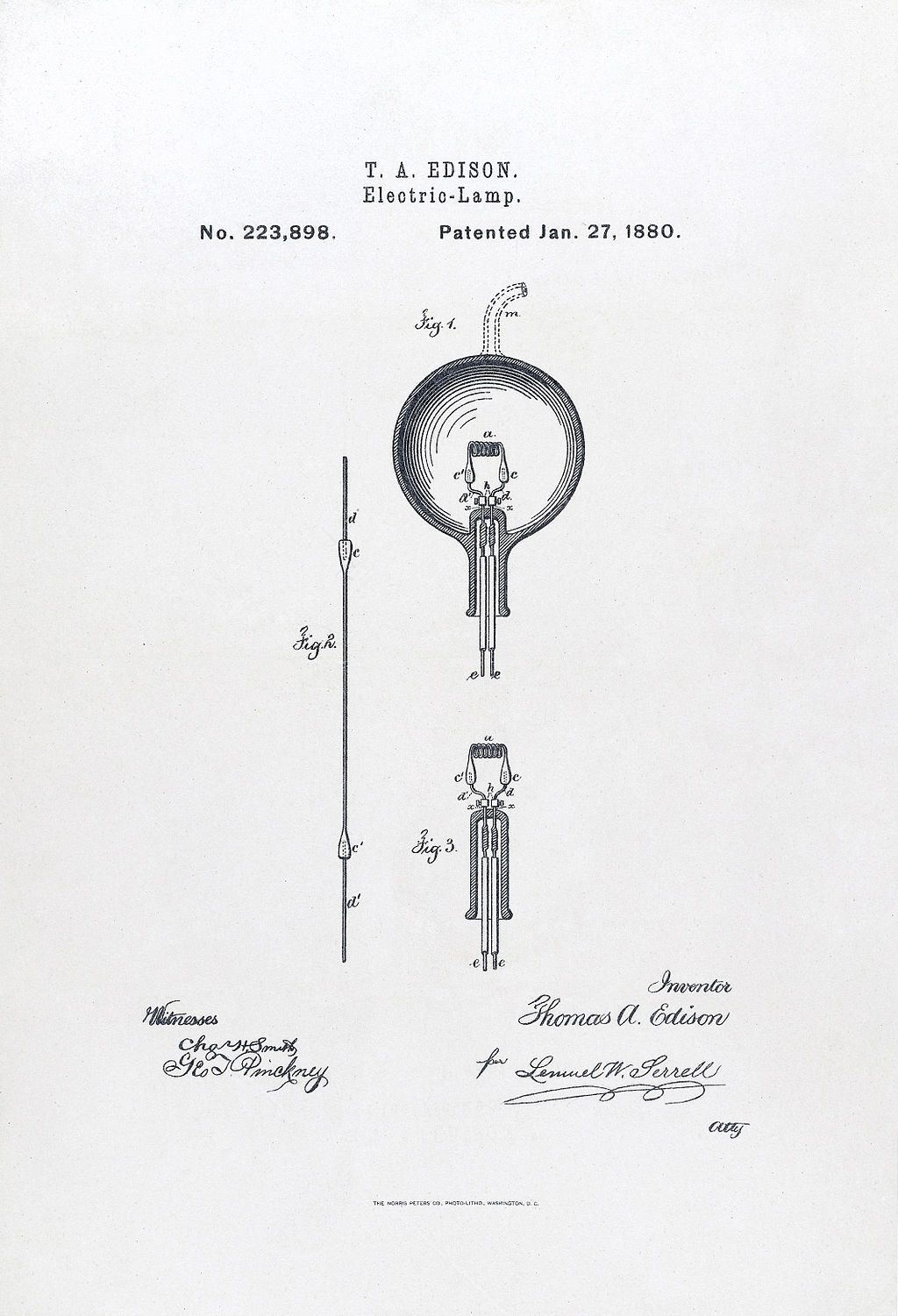
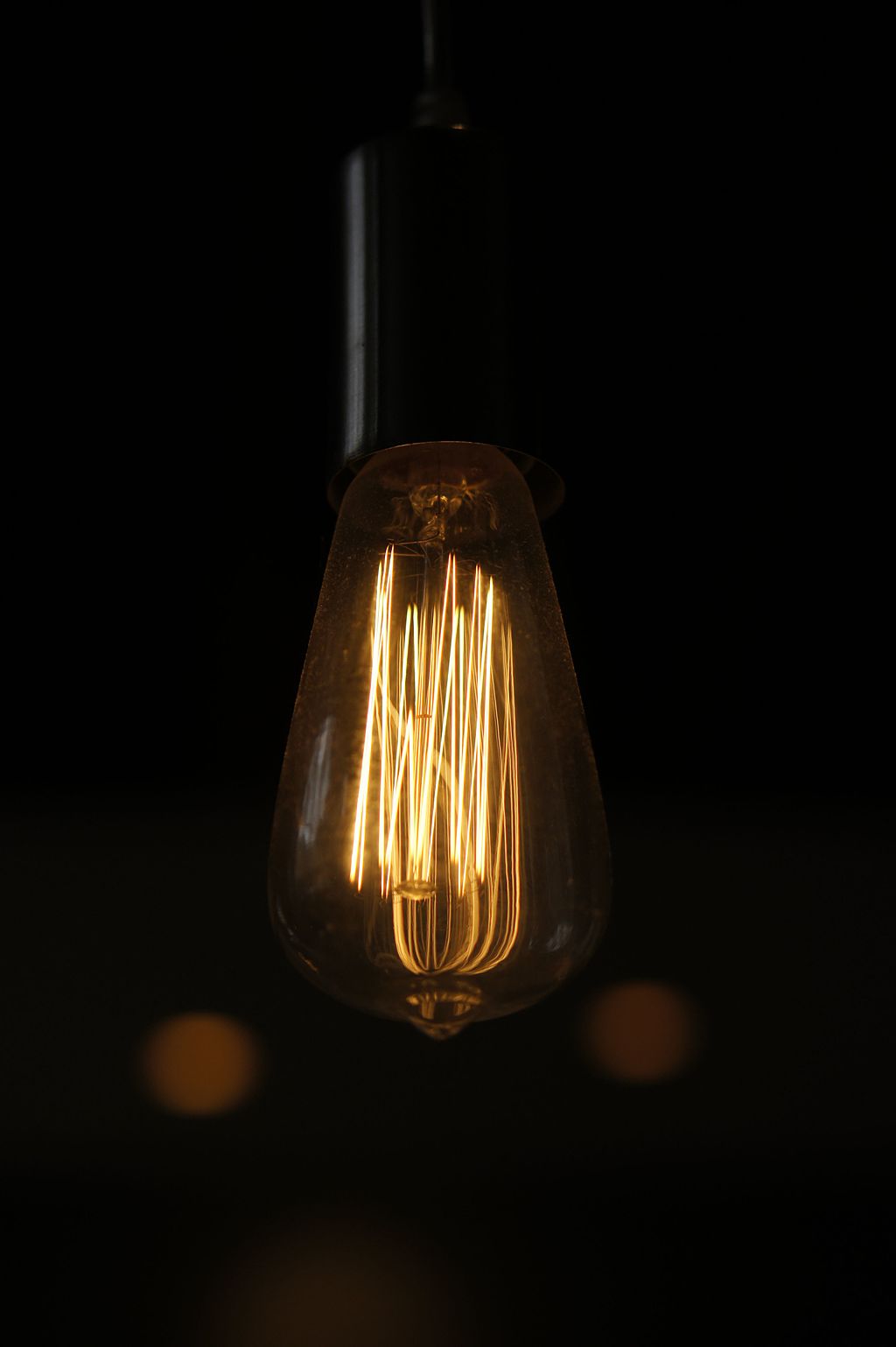
Thomas Edison saw the arc lamp, and grasped at once the potential for electric lighting to revolutionize daily life. But he had the vision to realize that the huge market opportunity was not in arc lighting, but in creating a less intense light source that could be used in any room. Already famous, and wealthy enough to run many experiments at his Menlo Park laboratory, Edison began a great R&D effort to create a practical electric light bulb, which became his most legendary, career-defining invention.
Incandescent bulbs had been demonstrated before Edison, but they were not yet practical: they burned out far too quickly. Edison’s contribution was to make a lasting bulb with a healthy glow. One key discovery was the importance of creating a vacuum in the bulb. Another crucial element was the filament; Edison’s lab famously tested thousands of materials to find a filament that would burn for many hours. A practical bulb allowed electric light to replace home lighting of kerosene or natural gas.
Electric lights were cleaner than gas or kerosene lamps—and electric motors were much cleaner than any kind of combustion engine (just imagine using a home dishwasher, refrigerator or vacuum cleaner that burns oil or coal). But to get these benefits, inventors had to solve the problem of distribution. The first home lighting system was installed in the mansion of banker J. P. Morgan, and relied on a steam generator constructed in a small building on his property, outside the house, complete with a full-time attendant to operate it. (The attendant went off duty at 11 p.m., and if Morgan’s family was up late, the lights would turn off without warning, sending them groping for candles in the dark.) To get his light bulb in homes less wealthy than Morgan’s, Edison planned an entire system of central generators and a power distribution network.
But there was a problem. Energy was being lost in the transmission lines themselves. This happens inevitably whenever current flows across a resistance (and even the best power lines have some resistance). Because of this, Edison’s system was still limited to about a half-mile radius, making it suitable only for very dense urban areas, where there would be many lighting customers within that small circle. It was never going to be economical in other locations.
The strict distance limit also made it impossible to take advantage of natural power sources, such as waterfalls. For thousands of years, factories had made use of water power through mills. But because we have no way to efficiently transmit mechanical power over long distances, those mills had always been tightly geographically constrained: they had to be on the river. Electricity was holding out the promise of finally breaking those geographic constraints, enabling true long-distance power transmission—if only we could figure out the problem of power loss.
Fortunately, a solution took shape—literally, because the root of the solution is in the shape of the current.
Let’s look again at how an electric generator works. The basic method is to spin a magnet near a coil of wire. The magnet is turned by mechanical power, such as a waterfall or steam turbine (in the latter case, the steam itself can come from any fuel source, from coal to gas to nuclear). The turning of the magnet creates a changing magnetic field, which, by fundamental laws of physics, creates an electrical field, which in turn causes electricity to move through a wire.
Because the magnet is turning in a circle, its magnetic field too is turning, and this creates, not a steady electric field, but an alternating one, which in turn creates an alternating current (AC). Instead of flowing in a constant direction, like water through a pipe, the electrons wiggle back and forth in the wire. (You might be surprised that this short-range wiggling enables long-range power transmission, but it does, because the wiggling motion propogates down the wire like a wave. Just as sound waves can reach your ears from miles away, even though no molecules of the air have actually traveled to you from the source, so electrical power can be drawn from the motion of electrons at the destination, even if no individual electrons have traveled all the way from the generator.)
At the time of the first generators, however, the only electric motors in existence required a direct current (DC) that traveled in a consistent direction. So, these generators converted AC into DC (using a more complicated generator design that involved brush contacts).
Both direct and alternating current could light up a light bulb just fine. And both could be generated easily enough (although the AC generator was more elegant, omitting the brush contacts). DC’s advantage in electric motors was leveled when the brilliant engineer Nikola Tesla invented an AC motor (it depended on “polyphase” AC, that is, multiple alternating currents where the alternations were out of phase with each other). The real, insurmountable difference was in transmission, because here AC could do something that DC could never do, something that would solve the problem of long-distance power lines and establish it as the electrical standard.
To understand this magic trick, we need to review a bit more of the physics of electromagnetism. Any electrical power line has a few basic physical attributes. The current is the rate at which electrical charge flows through the wire: literally, how many electrons per second are moving past a certain point. The voltage is a sort of electrical “pressure” applied to a wire: a greater voltage will produce a greater current. The resistance is analagous to friction that works against the current. When a current flows over a resistance, energy is lost, just as energy is lost to friction in a mechanical system. The amount of energy lost per second is proportional to the resistance, and to the square of the current. So to minimize energy loss, we must minimize both resistance and current.
To minimize resistance, you can use a low-resistance material such as silver or copper. Silver is slightly less resistive, but much more expensive, so copper is used in practice. You can make the wires thicker, because the resistance is inversely proportional to the cross-sectional area, but that uses more material, which is again more expensive. Thus resistance can only be lowered so much—and it gets worse with every mile, since it is proportional to the length of the wire.
The other way to minimize energy loss, then, is to reduce the current. But the wires still have to deliver power, and the power delivered is proportional to the current times the voltage. Therefore, to deliver a given amount of power with a low current, you need a high voltage.
But here we face another problem. A very high voltage is not suitable for domestic use. For typical daily use, you want electrical power available at about a hundred volts (the US standard today is a nominal 120V; Europe uses 220V). For long-distance power transmission, you want thousands of volts or more (modern lines use up to 765,000V!) If you brought that much power into the home, it would be far too much for a light bulb or electric motor, and it would present a danger of electrical shock or fire. But if you try to run power lines at only hundreds of volts, you lose too much energy to resistance.
How to solve this conundrum? Through an almost magical device called a transformer, which can convert low-voltage power to high-voltage and back. And it only works with alternating current.
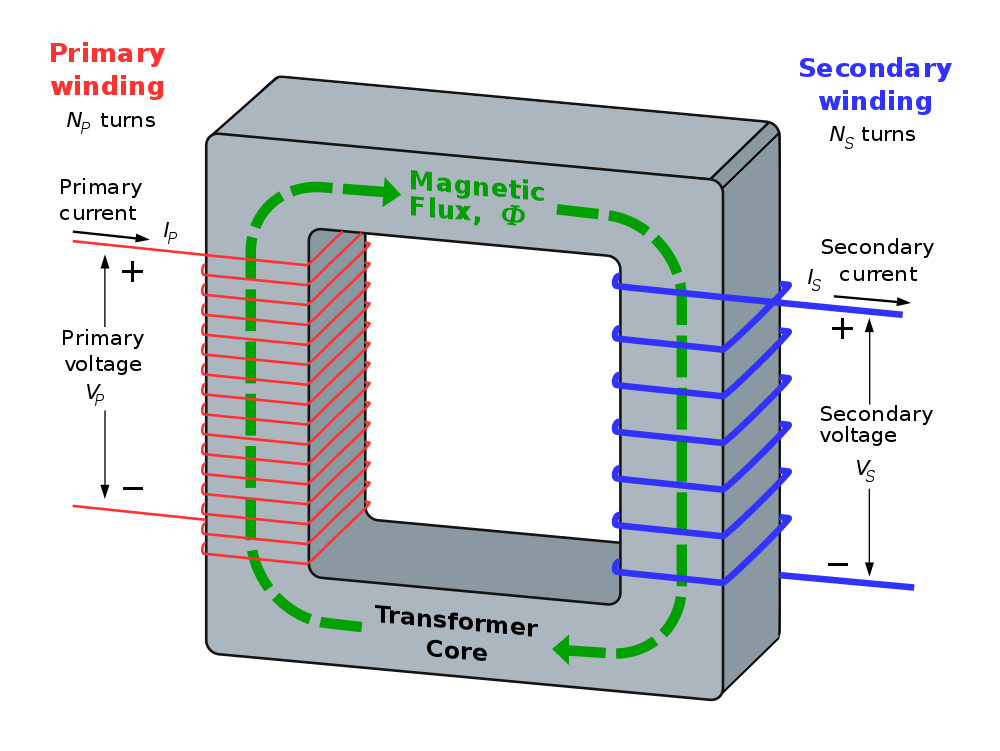
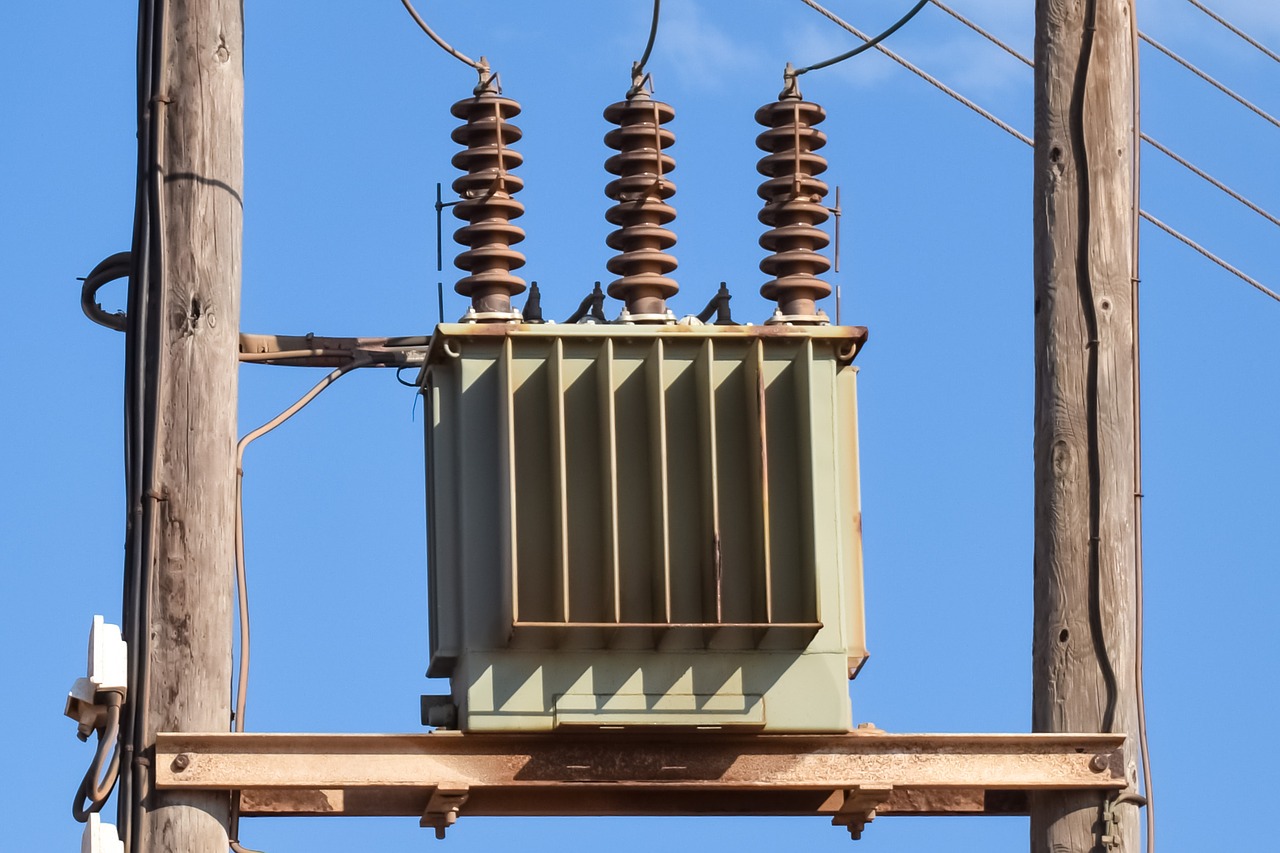
The seeming magic of the transformer is that the low-voltage and high-voltage wires don’t even touch. Instead, the power is transmitted via electromagnetic induction, that phenomenon discovered by Faraday in the 1830s. In a transformer, two coils of wire are wound around an iron core. As the current alternates in one coil, the iron becomes an alternating electromagnet. The alternating magnetic field then creates an alternating electric current in the other coil of wire. But if the number of turns in the two coils are different, then the voltage in the second coil will be different as well—higher or lower depending on whether the second coil has more or fewer turns than the first.
This works with AC because a changing magnetic field induces an electric field—but a stationary magnetic field does not, so it doesn’t work with DC. This is AC’s trump card, its decisive differentiator.
With AC, you can “step up” the current to a higher voltage for long-distance transmission, then step it down at the destination, such as a home, office or factory. The power travels long distances at high voltage and only short distances at low voltage, so very little energy is lost, but the desired voltage is still available to run lights and motors.
The advantage is analogous to shifting into the ideal gear when riding a bicycle. If you ride a bicycle in a low gear at a high speed on level ground, a lot of your energy just goes into moving your legs very fast, which is inefficient. By shifting into a higher gear, you can move your legs at a comfortable pace, while the wheels move much faster, thanks to the mechanical advantage created by the gears. The transformer is like a gear box for electricity.
George Westinghouse saw the value in the AC system and championed it. Edison, who had created a DC-based system, felt that high voltage was dangerous and argued against its use. The safety argument was compelling to many, but at the end of the day, a DC power grid was simply impractical—and Westinghouse’s sales figures proved it.
This was conclusively demonstrated by 1895, when the first hydroelectric power plant was built to harness the energy of the mighty Niagara Falls. An early plan for Niagara had called for a whole factory town to be built at the site, powered by water mills. But with electricity, the falls could deliver power to Buffalo, NY, located 26 miles away on the shores of Lake Erie.
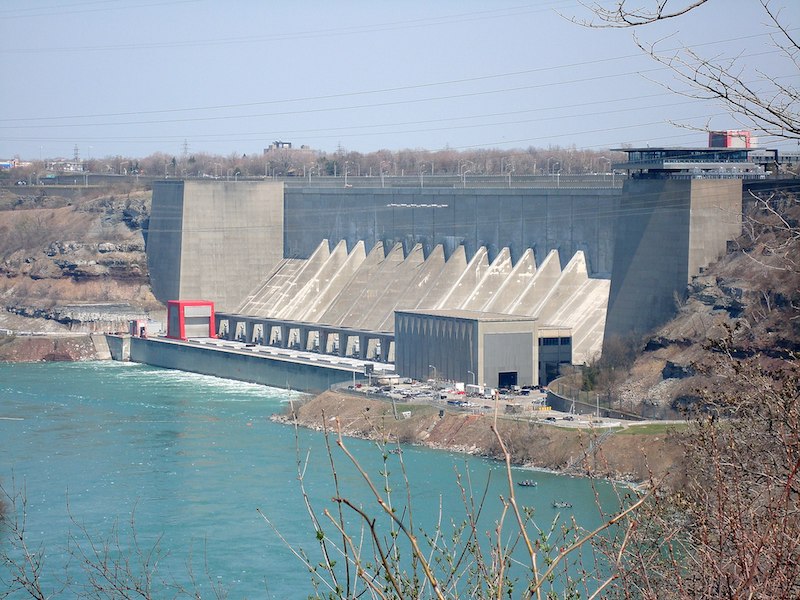
There is a popular narrative today in which Edison is a bumbling fool who missed AC and who didn’t really invent the light bulb, and Nikola Tesla is the brilliant genius who invented AC and motors, predicted the cell phone, etc. This is unjust in two ways.
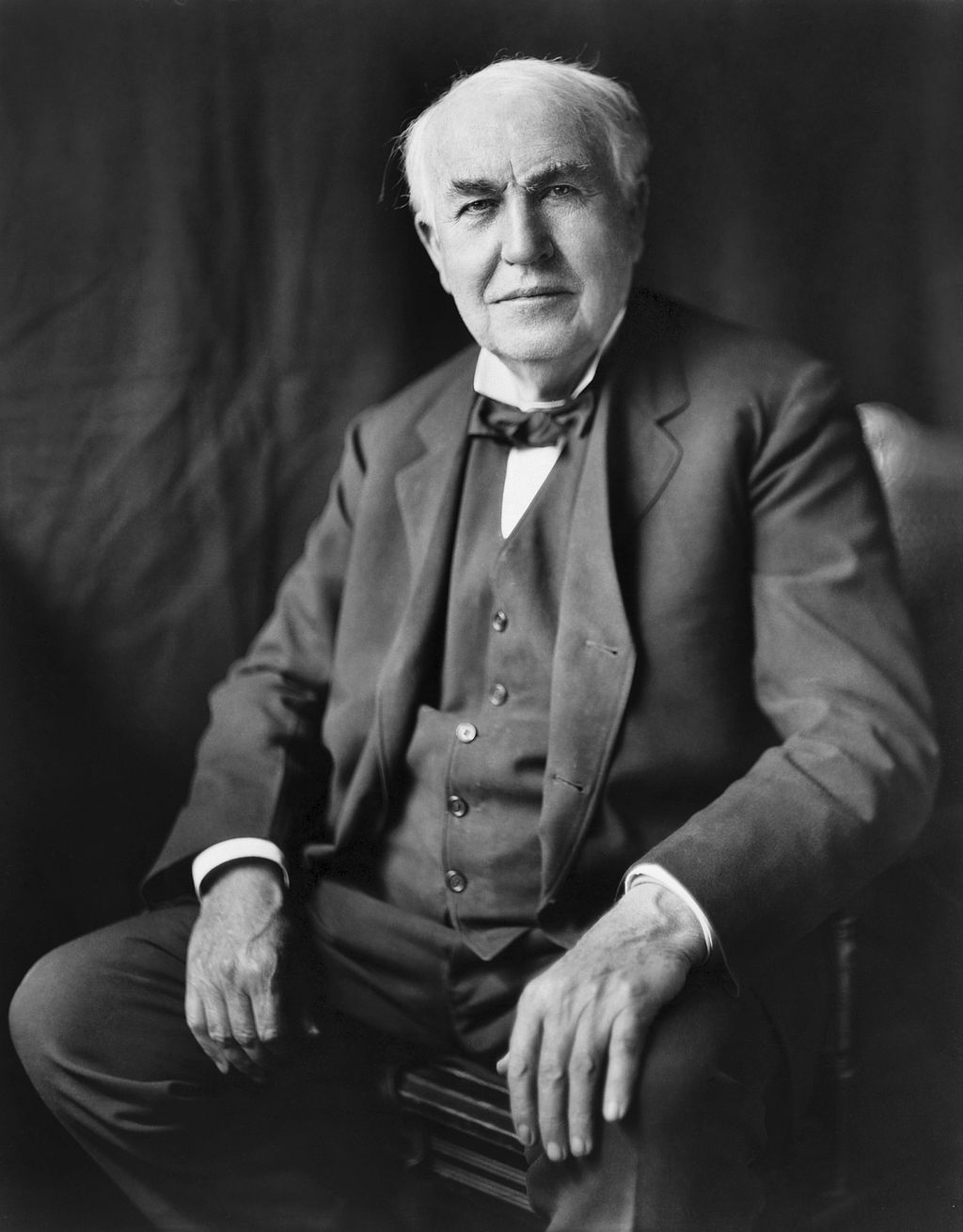
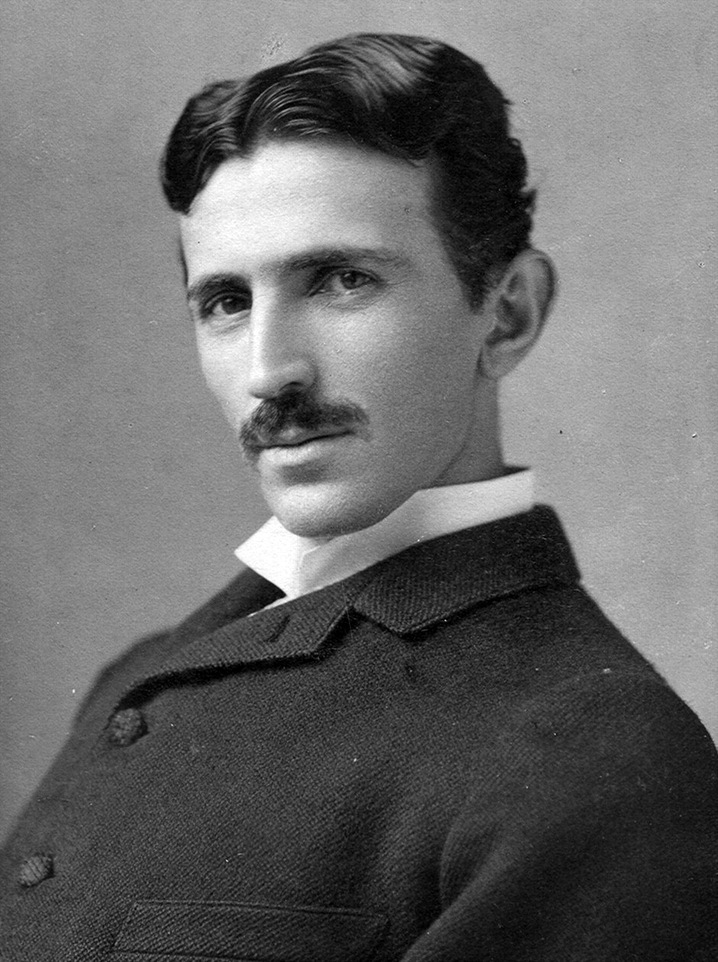
First, Edison was an inventive genius. He was wrong about AC, and in Jonnes’s telling, he seems to have been against it simply because it wasn’t his invention or his system. (He also participated in some dirty fighting against AC, such as a campaign to get AC, including Westinghouse-branded generators, instituted as a new form of execution for prisoners, in order to hurt Westinghouse by association with capital punishment.) But Edison was one of the few who saw early on the potential for incandescent lighting and the value of an electrical power grid, and he drove a huge investment in these technologies. And his lab did, for all practical purposes, invent the light bulb—certainly, no light bulb that existed before their experiments would have served.
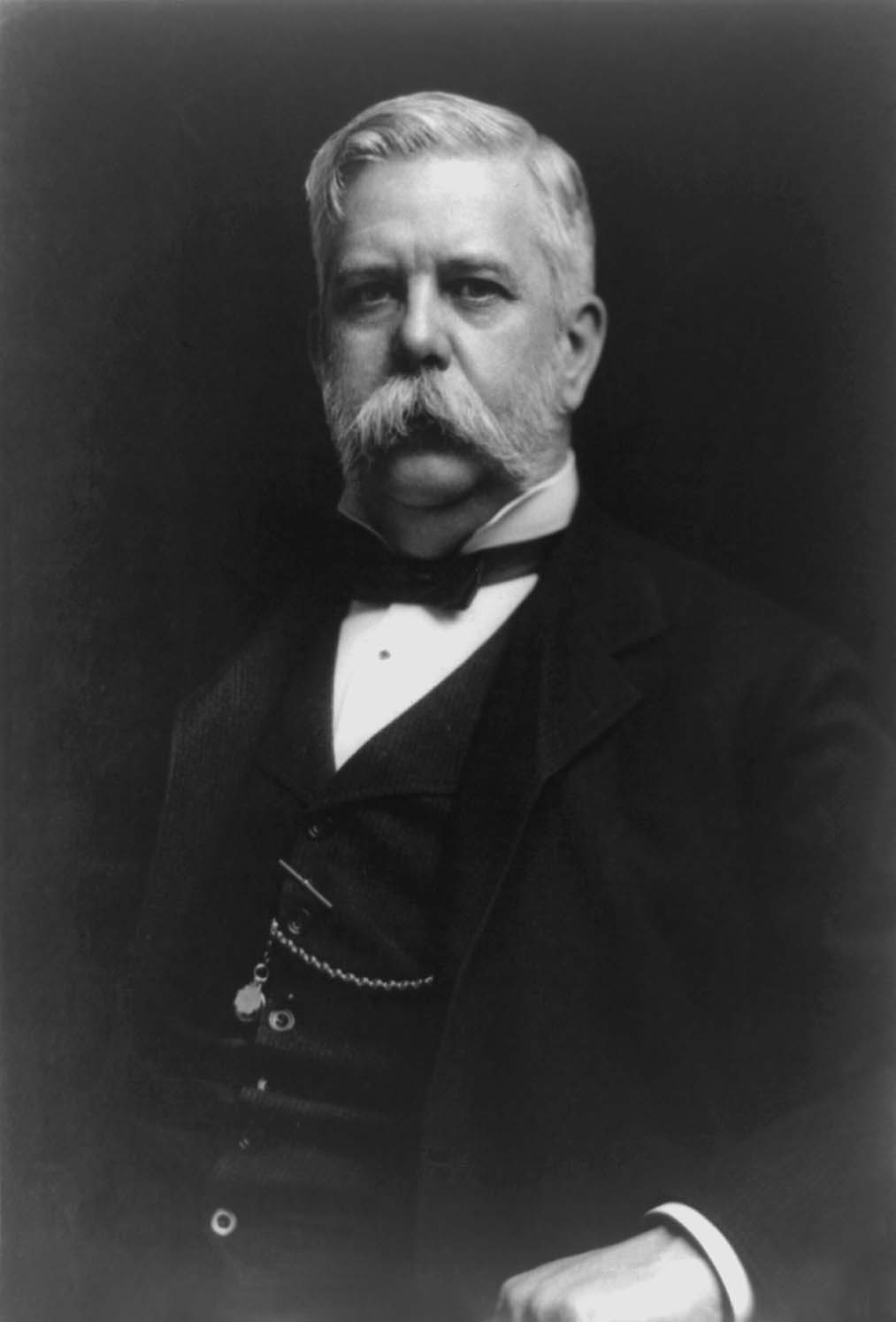
But even more importantly, the popular narrative takes no note of George Westinghouse. In Jonnes’s book, Westinghouse emerges as the true hero of the story. Tesla was a brilliant inventor who contributed some crucial innovations to AC power. But Westinghouse was the industrial visionary who made the power grid a reality. He got the financing, led the effort, made the sales, and deployed the system.
Moreover, he comes across as a man of honor and integrity. Here was his approach to publicity:
As the War of the Electric Currents grew uglier and fiercer, George Westinghouse decided in the fall of 1889 to hire a Pittsburgh newspaper reporter named Ernest H. Heinrichs to promote his companies and their achievements. On Heinrichs’s first day, Westinghouse came by to wish him success and explain his purpose. “All I want to see is that the papers print [things] accurately. The truth hurts nobody. …
“As to the attacks made against me personally, of course they hurt, but my self respect and conscience do not allow me to fight with such weapons. Besides, I feel that my moral reputation and my business reputation are too well established to be hurt by such attacks. However, I am preparing an article for the North American Review in answer to Mr. Edison’s charges against the Alternating Current system, but beyond that I shall have nothing to give you for publication…. By letting the others do all the talking, we shall make more friends in the end than if we lower ourselves to the level of our assailants.”
He displayed tremendous courage of his convictions:
As his old friend and biographer Henry Prout explained, Westinghouse was a great one for consulting others, “then he made up his own mind, and nothing milder than an earthquake could budge him. We have seen him sitting like a rock, serene, gentle, and unmoved when every member of the board of directors was against him. Whether he was determined or just obstinate depends upon your point of view.” Westinghouse had been right far too often when those he judged pusillanimous had been wrong. Why should he stop trusting his own formidable instincts?
Once, during a financial downturn, Westinghouse reorganized his company while retaining control:
Westinghouse’s lawyer, Paul D. Cravath, still marveled years later at this triumph of reorganization. Westinghouse, he said, “found it difficult to work with so-called financiers. What seemed to him to be their lack of vision and faith was always annoying to him…. In at least two great financial crises, when the financiers had given up the task as hopeless, Mr. Westinghouse, by his faith, by his untiring energy, and by the exercise of a power to influence men that I have never seen equaled, was able to weather the financial storm, raise enormous sums of money, and restore his enterprises to a sound financial position when his critics and most of his friends were certain that he was facing a crushing defeat.”
Years later, during another downturn, Westinghouse had to reorganize his company under bankruptcy (known in that era as “receivership”). He was amazingly sanguine, saying to his publicist:
“Do not forget to make it very emphatic to them [the newspapers] that this receivership is not the end of the company…. [The] company is fundamentally as sound and solid as ever, and it will emerge out of this unfortunate situation a greater and more prosperous concern than ever.” The bankruptcy was a great shock to both insiders and outsiders, but with money so tight, Westinghouse saw no alternative. He treated it matter-of-factly. “‘I grant you this is not pleasant,’ he told one friend. ‘But it isn’t the biggest thing in the world. All large business has its ups and downs. The crisis through which we are passing is only part of our day’s work.’”
He did save the company, and although unfortunately he had to give up control, and ultimately was pushed out, the Westinghouse Electric Corporation exists to this day.
The steam engine inaugurated the age of industrial energy, by providing a means to transform heat energy into mechanical energy. But electricity completed the energy revolution, by separating power generation from application. It allowed energy to be generated miles away, at a waterfall or a large, centralized fossil fuel–burning plant, and then to be used in homes and offices via clean electric lights and motors. It is indispensable to today’s standard of living. And we owe it to Westinghouse and AC.
Relevant books
Empires of Light: Edison, Tesla, Westinghouse, and the Race to Electrify the World
